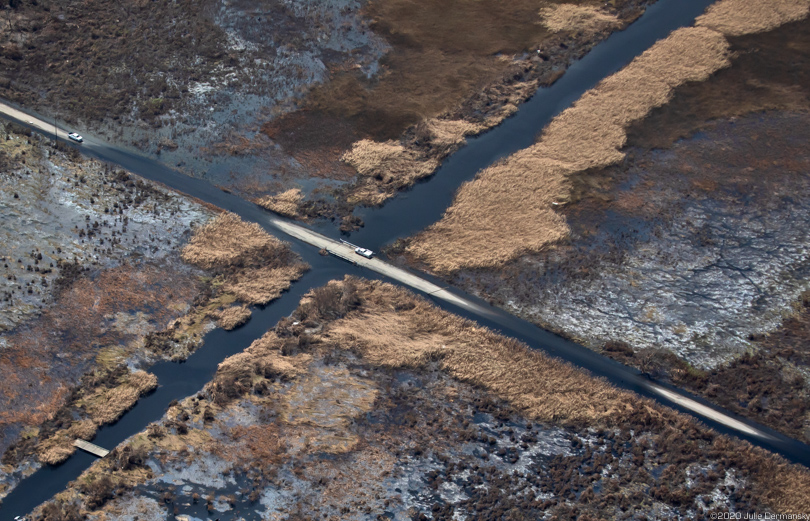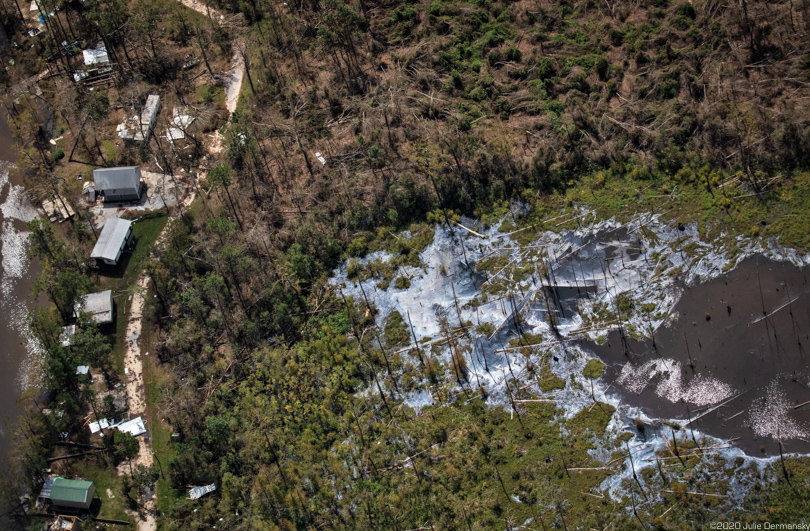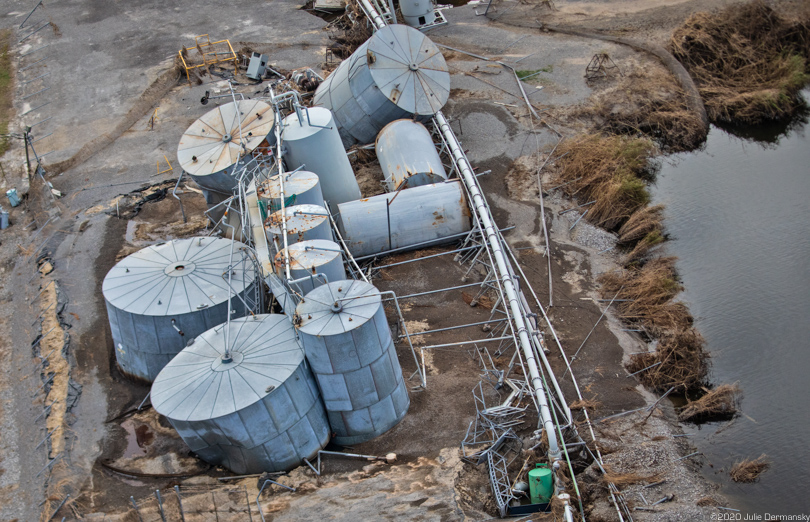Almost a week after Hurricane Laura struck Louisiana’s coast, which is studded with oil and gas industry pipes, tanks, wells, and rigs, I photographed from the sky oil sheen along at least 20 miles of marsh and bayous that absorbed the full strength of the storm. Scientists say warmer ocean waters due to human-caused climate change is making hurricanes like Laura stronger and causing them to intensify more rapidly. Hurricane Laura spun up to a Category 4 storm in just 24 hours.
For miles along the western Louisiana coastline near the Texas border, I spotted large swathes of land and water that appeared coated with oil, visible as the floodwaters receded between the small communities of Grand Chenier and Cameron. On September 2 and 3, I also documented oil sheen in waterways along the bayous from Cameron north to the city of Lake Charles and as far east as New Iberia, roughly 130 miles west of New Orleans.
Oil sheen near an oil and gas production site in New Iberia Parish, Louisiana, following Hurricane Laura.
Oil sheen in the wetlands inland from the Gulf of Mexico in Creole, Louisiana on September 2, 2020.
Oil sheen in floodwaters around homes in Cameron Parish, Louisiana, on September 3.
How much oil did Hurricane Laura’s impact cause to spill with its powerful winds, rain, and storm surge? While the storm made landfall on August 27, Louisiana Department of Natural Resources (DNR) spokesman Patrick Courreges told DeSmog it is still too early to assess the storm’s damage. “We are just 10 days out,” Courreges said by phone on September 8.
NOLA.com reported on August 27 that federal and state emergency responders would focus first on search-and-rescue operations before eventually pursuing oil spill inspections and possible cleanups.
While the hurricane’s storm surge was not as high as initially predicted, its coastal flooding and 150 mile-per-hour winds still left a trail of devastation.
Damaged cemetery in Cameron Parish on September 3, 2020.
Given the more than 1,400 oil wells in Hurricane Laura’s path, I was not surprised to find slicks of oil along the coast after the storm. However, the vast area of coastline now shimmering with oil and crumpled metal was a reminder of what any strong storm can do when it collides with the area of the Gulf Coast dotted with oil and gas production sites.
Louisiana has to worry not only about its active oil and gas wells, but also its thousands of orphaned wells, which are no longer in production and have been abandoned by their former owners.
Oil sheen near a tank spreading in floodwaters left in the wake of Hurricane Laura.
Oil containment boom in a tree in marshland along the Gulf Coast in Cameron Parish, Louisiana.
”[DNR’s] Office of Conservation decided to address orphaned well sites first, as the state would be the only entity likely to check on the conditions at those sites,” Courreges said by email. “Staff determined that approximately 480 orphaned well sites were located in the main path of Hurricane Laura and assigned inspectors to begin checking those sites the weekend after the storm passed. Though dealing with limitations such as remote site locations and road closures, through the first week following the storm, approximately 160 site visits have been made by inspectors.”
Additionally, DNR is responding to reports of spills and damage from other agencies, oil and gas operators, and the general public, according to Courreges.
Before the storm’s arrival, DNR asked oil and gas industry operators to take various preventive measures to secure equipment and reduce the likelihood of spills, said Courreges, adding that the state can hold accountable those operators who failed to make appropriate preparations that later led to environmental impacts.
Boat in the marsh next to a storage tank near Westlake, Louisiana.
Oil sheen near homes in Westlake, in western Louisiana.
The Louisiana Mid-Continent Oil & Gas Association, an industry trade group, told NOLA.com that companies have learned a lot from previous storms such as Hurricane Katrina and are constantly updating hurricane preparation and response plans alongside a range of government partners. But even the best efforts to prevent spills aren’t a guarantee, and DNR confirmed that the oil and gas industry already has reported to the agency damage and spills.
By August 29, the U.S. Coast Guard’s National Response Center had received 31 reports of oil and chemical spills related to Hurricane Laura, according to a U.S. Environmental Protection Agency report reviewed by New Orleans Public Radio. That report suggests that most of the spills occurred in coastal waters, and National Response Center data available online indicates additional spills from Hurricane Laura, including a crude oil spill from a pipeline attached to a platform near Morgan City, about 85 miles west of New Orleans, which was reported August 30.
Damaged oil and gas industry tanks in Cameron, Louisiana.
On September 2, I shot photos of some of the damage left in Laura’s wake for the Louisiana Environmental Action Network (LEAN), a nonprofit environmental advocacy group. The next day, David Levy, owner of Petrotechnologies and founder of the Free Iberian Press, took me on a flight to shoot impacts to the coast for DeSmog, covering some of the same ground. Levy, whose company serves the oil and gas industry, is continuing to monitor oil slicks from the sky as a concerned citizen. “All oil industry folks aren’t bad people wanting to destroy the plant,” Levy said. “The oilfield needs to contribute to a sustainable world and we have the technology to do it. We only lack leadership,” he added.
The oil spills resulting from the hurricane are not a surprise to environmental scientist Wilma Subra, a technical advisor for LEAN and recipient of the MacArthur Fellowship Genius Award.
Oil sheen near homes damaged by Hurricane Laura in Cameron Parish.
“The oil sheen could come from numerous sources, from households to offshore oil rigs,” she said by phone. Subra cautions that people should take care when they return to the area affected by Hurricane Laura because they could be exposed to a range of hazardous chemicals from the spilled oil, including benzene, toluene, and polycyclic aromatic hydrocarbons.
Residents heading back to the Lake Charles area not only have to watch out for spilled oil, which I also spotted in surrounding bayous, the city itself, and neighboring Westlake, which is home to numerous petrochemical plants. They also have to worry about possible air pollution, says Subra. Normally she would warn people to stay inside and keep their windows closed if they smell something bad, but that becomes especially difficult with so many people still without power.
The state Department of Environmental Quality set up two mobile air monitoring labs in Lake Charles because its usual air monitors there have been without power since the hurricane.
Water being sprayed on BioLab Inc., a chlorine plant in Westlake, Louisiana, on September, 3, 2020. The plant caught fire and released toxic chlorine gas after the hurricane.
One particularly worrisome facility is the nearby BioLab petrochemical plant in Westlake, which experienced a chemical fire and toxic chlorine gas release in the wake of Hurricane Laura. On September 3, I photographed plumes of water still spraying the damaged chlorine plant.
According to NOLA.com, Hurricane Katrina slammed into similar oil and gas industry infrastructure in 2005, causing about 540 spills that together released roughly 11 million gallons of oil into Louisiana waters alone. ”[F]ifteen years later, no environmental damage assessments have been completed and no companies were fined,” reported the newspaper.
Oil sheen among homes, marshes, and Hurricane Laura floodwaters in Cameron Parish.
Oil sheen in Vermilion Parish.
In addition to the climate crisis supercharging storms, scientists continue to warn that rising sea levels from melting ice sheets in Antarctica and Greenland are making coastlines like Louisiana’s even more vulnerable to environmental disasters. A study published on August 31 in the peer-reviewed scientific journal Nature Climate Change notes that such “melting is overtaking the climate models we use to guide us, and we are in danger of being unprepared for the risks posed by sea level rise.”
Dr. Anna Hogg, study co-author and climate researcher at the University of Leeds in England, said in a statement: “If ice sheet losses continue to track our worst-case climate warming scenarios we should expect an additional 17cm [6.7 inches] of sea level rise from the ice sheets alone. That’s enough to double the frequency of storm-surge flooding in many of the world’s largest coastal cities.”
Meanwhile, the state of Louisiana continues to issue permits for new fossil fuel and petrochemical industry projects, including 15 permits to the Taiwanese petrochemical corporation Formosa for its $9.4 billion plastics manufacturing complex. Other oil and gas infrastructure projects newly built or currently under construction in the state, such as Entergy’s natural gas power plant in New Orleans East and Energy Transfer’s Bayou Bridge oil pipeline, will exacerbate the climate crisis. These developments will add to the state’s existing greenhouse gases emissions, which, as Hurricane Laura reminds us, then increase the threats to the very same facilities.
Oil in the wetlands in Cameron Parish on September 3, 2020.
Oil sheen in a bayou in Cameron Parish.
Oil sheen in Cameron Parish wetlands following Hurricane Laura.
Main image: Road in Cameron Parish with remaining floodwater from Hurricane Laura and surrounded by oil-coated wetlands. Credit: All photos by Julie Dermansky for DeSmog
Subscribe to our newsletter
Stay up to date with DeSmog news and alerts























